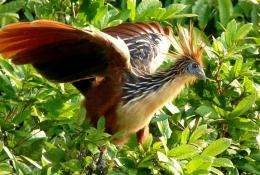Across the Atlantic on flotsam: New fossil findings shed light on the origins of the mysterious bird Hoatzin

A team comprising German, Brazilian and French scientists, including an ornithologist from the Senckenberg Research Institute Frankfurt, has examined fossil relatives of the South American Hoatzin (Opisthocomus hoazin), which point to African origins for the enigmatic bird. The accompanying study is being published by the journal Naturwissenschaften today.
The Hoatzin is a funny old bird: a poor flyer, the chicks equipped with claws on their wings, it lives on the banks of the Amazon and Orinoco basins in South America. What is particularly unusual about this bird is its purely vegetarian diet. Digestion does not only take place in the stomach but above all in a greatly enlarged crop, where bacteria help to decompose the food. The digestive system of the Hoatzins is very reminiscent of that of a mammalian ruminat.
But not only is the anatomy of the bird unusual; its relationship is still unclear. Since its scientific description in 1776, the Hoatzin has been bracketed alternatively with game birds, cuckoos or the African turacos. However, no relationship with these groups has been proven convincingly until now. For this reason, the bird is usually allocated its own family and genus. The evolutionary origin of the Hoatzins has been unknown so far, and apart from some very fragmentary remains, there were no fossil remnants.
Now a team consisting of German, Brazilian and French researchers, including the ornithologist Gerald Mayr from the Senckenberg Research Institute, has not only described the earliest known fossil find of the mysterious bird group, but has also produce the first proof outside of South America.
Upper arm and shoulder girdle bones, around 23 million years old, from a site in southeast Brazil, which are kept in the Museu de História Natural de Taubaté in Brazil, are the first ever fossil finds of a Hoatzin. The large similarity between the fossils and the corresponding bones of the present-day Hoatzins suggest that the bird developed its unusual nutritional biology at a very early stage.
As well as the Brazilian findings the researchers also examined 17 million year old bones from Namibia, which revealed surprising findings on the earlier geographic distribution of the Hoatzins. Until now the African fossil finds, described a few years ago as Namibiavis senutae, were allocated to an extinct family of cranes. “However, this allocation can no longer be supported, because the finds demonstrate characteristic bone features of Hoatzins,” explains Gerald Mayr.
When two related animal groups are discovered on different continents, this can be explained in principle by two mechanisms: either the continents were once connected by land, or the distribution took place directly across the water.
Africa and South America were once part of a supercontinent called Gondwana, but this had already broken up much longer than 20 million years ago, the continents being separated by the Atlantic. So Hoatzins must have crossed the ocean at some stage in order to get from one continent to the other.
But how does a bird, which is an especially poor long-distance flyer, manage to cross a sea that is over 1,000 kilometres wide? Even if the flying capabilities of the Hoatzin’s ancestors were better, it is highly unlikely that they could have managed this distance in the air.
Gerald Mayr and his colleagues from Brazil and France have an explanation that is somewhat unexpected for birds: “We assume that the bird crossed the Atlantic upon drifting flotsam.” This means of travel using flotsam is already familiar with regard to some primates, rodents and lizards, but it would be the first proof of a similar journey by a bird.
Due to the Cenozoic ocean currents and wind directions, a journey across the Atlantic was only probable in a westerly direction. The scientists assume, therefore, that “South America’s most enigmatic bird” has its origins outside of South America and arrived there from Africa.
More information: Gerald Mayr, Herculano Alvarenga and Cécile Mourer-Chauviré, Out of Africa: Fossils shed light on the origin of the Hoatzin, an iconic Neotropic bird, Naturwissenschaften, DOI:10.1007/s00114-011-0849-1
Provided by Senckenberg Research Institute
















